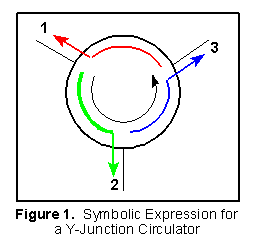![]()
CIRCULATORS AND DIPLEXERS
![]()
| Home | Products | Services | Technical Support | Profiles |
|
|
|
CIRCULATORS AND DIPLEXERS |
| ||||||||
| ||||||||||
|
|
 A
microwave circulator is a nonreciprocal ferrite device which contains three or
more ports. The input from port n will come out at port n + 1 but not out at any
other port. A three-port ferrite junction circulator, usually called the
Y-junction circulator, is most commonly used. They are available in either
rectangular waveguide or strip- line forms. The signal flow in the three-port
circulator is assumed as 1 to 2, 2 to 3, and 3 to 1 as shown in Figure 1. A
microwave circulator is a nonreciprocal ferrite device which contains three or
more ports. The input from port n will come out at port n + 1 but not out at any
other port. A three-port ferrite junction circulator, usually called the
Y-junction circulator, is most commonly used. They are available in either
rectangular waveguide or strip- line forms. The signal flow in the three-port
circulator is assumed as 1 to 2, 2 to 3, and 3 to 1 as shown in Figure 1.
If port 1 is the input, then the signal will come out of port 2; in an ideal situation, no signal should come out of port 3 which is called the isolated port. The insertion loss of the circulator is the loss from 1 to 2, while the loss from 1 to 3 is referred to as isolation. A typical circulator will have a few tenths of a dB insertion loss from port 1 to 2 and 20 dB of isolation from port 1 to 3 for coaxial circulators (30 dB or more for waveguide circulators). When the input is port 2, the signal will come out of port 3 and port 1 is the isolated port. Similar discussions can be applied to port 3.
 The Maximum Input Power to a Measurement Device - The ideal input to a measurement device is in the 0 to 10 dBm ( 1 to 10 mW) range. Check manufacturer's specification for specific maximum value. If the RF transmission lines and their components (antenna, hybrid, etc.) can
support the wider frequency range, circulators could be used to increase the
number of interconnecting RF ports from two as shown in Figure 5, to four as
shown in Figure 6.
Figure 7 shows an alternate configuration using diplexers which could
actually be made from circulators as shown previously in Figure 3. 
|